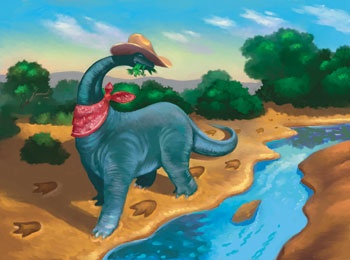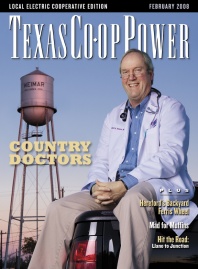We don’t usually think of dinosaurs when we think of Texas. We might think about the state’s officially designated large mammal, the Longhorn, or the state small mammal, the armadillo. We know that the state bird is the mockingbird, the state tree is the pecan and that the horned lizard (or horny toad, as most of us call it) is the state reptile. Rock hounds might even know that the state stone is petrified palm wood.
But seldom is heard a word, discouraging or otherwise, about the state dinosaur, the Pleurocoelus.
Whether or not Texas actually needs a state dinosaur is open to debate, but the Pleurocoelus (PLOOR-oh-SEEL-us) was so designated by the Legislature in 1997. It’s our dinosaur, by golly, and we’re Texans, so we’re going to be proud of it, even if it wasn’t what you might call ferocious.
Our dinosaur was a strict vegetarian. At least it was big—it was about 45 feet long and weighed in at about 10 tons. Paleontologists tell us that despite its size, our dinosaur was decidedly mild-mannered.
The Pleurocoelus (brachiosaur sauropod) hasn’t been seen in these parts for, oh, about 65 million years. But we have proof set in stone that they lived here.
Near Glen Rose, at the appropriately named Dinosaur Valley State Park, on the banks of the Paluxy River and in the riverbed itself are some remarkably well-preserved Pleurocoelus tracks. These are some of the best dinosaur tracks in the world, which is why paleontologists have loved the park ever since Roland T. Bird of the American Museum of Natural History visited the site in 1938.
Bird realized that a set of double tracks showed an herbivorous sauropod—most likely the Pleurocoelus—being chased by a meat-eating carnosaur. This was the first time sauropod tracks had been discovered anywhere in the world, which caused no small amount of excitement back in New York. A section of the Glen Rose tracks was duly sent to New York and displayed at the American Museum of Natural History, where it remains today.
Since the Pleurocoelus’ trip across the riverbed that day, the fossilized tracks it left behind have been excavated and scattered hither and yon, to the Texas Memorial Museum in Austin and the private residences of many amateurs—or vandals, depending on how you look at these things.
It took a special set of circumstances to preserve the tracks for all these millions of years. Scientists believe that a violent storm blew across the shoreline a few days before the tracks were made and created a series of sand- and lime-laden mudflats. A herd of Pleurocoelus came ambling across the sticky and still-wet mud in search of a primordial salad, followed in interested pursuit by the carnosaurs.
True to their nature, the Pleurocoelus tried to run away, but we don’t know whether they won that particular footrace or not. No intact skeletal remains were ever found, just huge saucer-like depressions from their hind feet and smaller tracks, much like horseshoes, from the front. The primal struggle for food and survival was preserved when the seashore turned to stone, leaving behind the rocks we see in the park today, including the ones with the dinosaur prints.
Texas has had its fair share of fossilized dinosaur discoveries over the years due to a quirk of ancient geography dating back to when much of what is now Texas was an ancient sea.
As the sea level rose, the land was covered with ocean silt. Sediments on the bottom of the ocean preserved things that lived in the ocean. As sea levels dropped, traces of things that lived on land were preserved in sediments left in streams and rivers, like the Paluxy. As a result, dinosaur discoveries in Texas have included both the marine and terrestrial, along with the creatures that flew over both land and sea.
Having a state dinosaur prompts us to take official note of ancient Texas. And wildness is wildness, whether it’s slinking across your pasture tonight or it lived millions of years ago and you’re literally walking in its footsteps.
——————–
United Cooperative Services serves Dinosaur Valley State Park.
Clay Coppedge is a frequent contributor to Texas Co-op Power.


